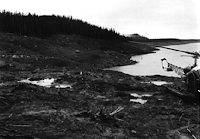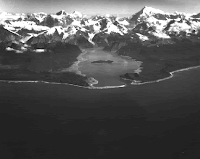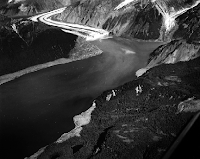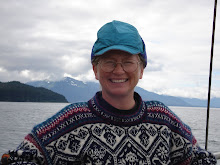
 O
O
| |
Occccceannnnn… Climate, culture, ocean
40 million square miles
12,200 average feet deep Mariana Trench 36,198 feet deep
Ocean ridge mountain 40,000 miles long --
the longest mountain range known in our universe
Mauna Kea rising 33,474 feet from the ocean floor to the sky
Oooccccceannnnnn…71 % of our planet’s surface
Containing 97% of our planet’s water
Holding heat near the surface Deep as 2.5 miles
Providing 99 % of earth’s living space
| C
|
ontaining the abyss habitat With less than 10% explored by humans
Challenger Deep is one mile deeper than Mt. Everest is high.
Avg. 2 degrees C or 39 degrees F
| E |
xtreme water pressure of 8 tons per square inch Gulf Stream flowing 300 times faster than the
Amazon flow Containing 20 million tons of gold Blue absorbed by phytoplankton, drifting
Deep-sea hydrothermal vents along mid-ocean ridges Holding new life
Blue whale, heart larger than an automobile
Grey whale migrating across 10,000 miles of ocean each year
Great Barrier Reef, seen from the moon. Oceans threatened by oil Fisheries fishing
Overfishing Pollution cities by the sea polluted coastal waters Plastic, plastic, plastic
| A |
Coral reef is degrading Coral reefs declining High seas least protected treaties agreements
Protections Critical marine habitats Coral reefs, seagrass beds, mangroves
Commercial fishing, illegal fishing, by-catch destruction Coastlines 315,000 miles,
circling equator 12 times Coastal zones, half the world’s population within 60 miles of coastlines
Rising sea level 4-10 inches over past 100 years Ice melting, oceans rising
Volcanoes from the oceans 10 % of earth’s surface covered with ice
Sea levels determined by ice not melting Occcceannnnns… Containing salt
Absorbing carbon dioxide Plankton forming the base of the food web Reefs threatened
Contamination, oil, plastics, destruction Ocean planet, ocean home, distress
| N |
OW Ocean planet, worth protecting Appreciating Recognizing water in us
Recognizing ourselves as encapsulated oceans of salty water, environments as ourselves
In ourselves, elements of the ocean entity.
Would students be interested in taking words and phrases from facts about oceans and turning them into their own poetry, then making music from the words, or adding drum beats? Use themes of thermal energy, underwater plant life/phytoplankton; seasonal patterns; seasonal changes on earth and in the water; solar energy; sea surface; temperature; winds; currents; evaporation; water circulation; ice; Gulf Stream; water density; thermohaline conveyor; others?
Consider LATTITUDE in understanding oceans, temperatures, effects on the land where we live.
In discussing and using GOOGLE EARTH for looking around the globe, consider showing the film LONGITUDE, to show how cultures transform as elements of the ocean become understood over time.
…”Longitude combines drama, history, and science into a stimulating, painstakingly authentic account of personal triumph and joyous discovery… The first story involves the successful 40-year effort of 18th-century clockmaker John Harrison…to solve the elusive problem of measuring longitude at sea. In 1714 the British Parliament had offered a generous reward to anyone who solved the problem, and Harrison devoted his life to that solution. The second story, some 200 years later, involves the effort of shell-shocked British Navy veteran Rupert Gould (Jeremy Irons) to restore the glorious clocks that Harrison had built. Like Harrison, Gould is the most admirable type of obsessive, but, also like Harrison, he risks his marriage to accomplish his difficult task.
Thousands of sailors perished at sea before Harrison's triumph changed history, but Longitude demonstrates that Harrison's glory was slow to arrive--and his prize money even slower. A fascinating study of 18th-century British politics and clashing egos in the arena of science, the film is both epic and intimate in consequence… Rallying after sickness to prove the integrity of their marvelous seafaring chronometers, the Harrisons still had to fight for official recognition, and Gould's restoration of the Harrison clockworks provides a fitting coda to this exceptional story about the thrill of discovery and the tenacity of remarkable men. --Jeff Shannon
*********
IN MY LIFE, my father was in the Navy off of the Aleutian Islands near Adak during WWII. He was from inland in North Carolina, so this was a whole new world for him, and he loved it. Ten years after the war, he brought his family back to Juneau, S.E. Alaska. I grew up rowing and going fishing, on the water a lot around Auke Bay, Tee Harbor, Lena Cove, and northern Admiralty Island. From the age of 18, I ran a small pleasure boat myself in the same region. Then I married a boat driver, boat builder, [See sailglacierbay.com)]and have proceeded to live my life on the water: charter fishing, subsistence set netting, working as a naturalist, kayaking with guests with humpback whales, exploring the outer coast off of Yakobi, traveling between Sitka and Gustavus, weather watching, sailing..
The satellite would travel overhead for about 40 minutes during predicted high winds (using light reflected off of the ocean in satellite video). During this 40 minutes, Fritz would keep the boat headed into the wind during periods of 5 minutes, during which I recorded wind data -- direction, amplitude and Beaufort Scale number -- data from our anemometer attached to our 30-foot high sail mast, reading in the wheelhouse. We read weather data in the dark, in the wind, dealing with current and tides, trusting the instruments and our faith in the boat on the water. I learned a lot. There are patterns to the wind, changes with tides and currents, and patterns of the wind on water in open ocean and closer to large (Chichagof) and small island (Pleasant Island) shores.
We rode the sea and gave data to compare that coming from the satellites. I've never before felt like a scientist, nor a native using my local knowledge to stay in control and record nature. I realize how new the satellite data is, and how native stories and knowledge must be used to understand a longer period of time, from long before the satellites circled our earth.
Now seeing the videos of native villages, oceans currents, density, patterns of water directions, I can see how scientific data can mesh with native ways of knowing. It takes close knowledge of an area to decipher knowledge gathered from the sea. (Paul Marks, "..living by the moon, by the seasons, being interdependent on the sea.") I see images for artistic representation in the themes of subsistence: images of hunting, fishing, gathering, teaching, learning, celebration always with respect and honor for the land, the sea, the animals. (TD Living from Land and Sea): salmon, bowhead whale, seals, sealions, forage fish, sandlance. Dolly Garza, Tlingit and Haida woman from Sitka, states her obligation to protect native rights. She can hunt sea mammals, and understands subsistence, consumptive and artistic uses.






